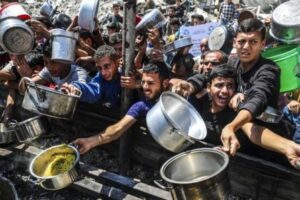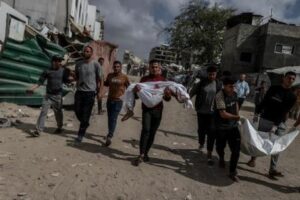The historical Zionist project is the expulsion of all Palestinians from the land of Eretz Israel, which is seen as the historic Jewish homeland. Israeli leaders have always seen this as a huge, long-term project which was so vast it could only be achieved in stages. The 1948 Nakba was the first stage, the 1967 conquest of Gaza, the West Bank and the Golan Heights was the second one, and the recent destruction of Gaza the third. If it holds, the new ceasefire marks a new landmark on Israel’s long journey of destruction against the Palestinian people. It is certainly not the last chapter of this long saga. The purpose of this article is to explain the reasons for this assessment and where the situation stands today.
Details of the agreement
What exactly has happened? On Thursday January 16, in Doha, representatives of Hamas and the Israeli government officially signed the ceasefire agreement. The lengthy preceding negotiations had been mediated by the United States, Qatar, and Egypt. US chief negotiator Brett McGurk was joined in recent days by Trump’s representative Steve Witkoff. The details of the agreement aren’t very different from the draft submitted by the Biden administration last summer.
Al Jazeera provides a straight-forward summary of the agreement:
First phase
- Thirty-three Israeli captives, including women, children and civilians over the age of 50 will be released.
- Israel will release a larger number of Palestinian prisoners during this phase.
- Israel to withdraw its forces from Gaza’s population centers to areas no more than 700 meters (2,297 feet) inside Gaza’s border with Israel.
- Israel will allow civilians to return to their homes in the enclave’s besieged north and allow a surge of aid into the enclave of up to 600 trucks per day.
- Israel will allow wounded Palestinians to leave Gaza for treatment and will open the Rafah crossing with Egypt seven days after the start of the implementation of the first phase.
- Israeli forces will reduce their presence in the Philadelphi Corridor, the border area between Egypt and Gaza, and then withdraw completely no later than the 50th day after the deal comes into effect.
Second phase
- If determined that the conditions have been met for a second phase, Hamas will release all remaining living captives, mostly male soldiers, in return for the freeing of more Palestinians held in Israeli prisons.
- Israel would initiate its “complete withdrawal” from Gaza.
Third phase
- Should the conditions of the second stage be met, bodies of the remaining captives will be handed over in return for a three- to five-year reconstruction plan to be conducted under international supervision.
Background to the agreement
This agreement poses a number of questions. First, will the Israeli far right be able to scuttle it? The situation is moving rapidly. At the time this article is being written (January 17) the Israeli War Cabinet has endorsed the agreement, and the full Cabinet is debating approval. Predictably Bezalel Smotrich and Itamar Ben-Gvir, leaders of the hard right, have come out in full opposition to any settlement or treaty. The pundits’ consensus is that Netanyahu will probably secure agreement for the ceasefire, although future political turbulence appears quite likely.
Second, if a ceasefire is finally confirmed, will Israel abide by it? Israel has violated the accord with Hezbollah to end the fighting in Lebanon 564 times, according to the Lebanese government. There’s every reason to believe that Israel will find some excuse to violate the new agreement with Hamas.
Third, what is Israel doing right now? Israel is seeking to inflict as much damage as possible on the Palestinians in the hours and days leading up to the Sunday January 19 implementation of the ceasefire. Some 103 Palestinians have been killed and 264 injured since the Wednesday announcement of the ceasefire. This extraordinary figure should remove any hope that the ceasefire represents a new benevolent Israel.
Four, where does the situation in Gaza stand on the eve of the ceasefire? The statistics are extraordinary. The official figures stand at 46,788 dead and 110, 553 injured. The well respected British medical journal The Lancet believes that this is an underestimate and the real death toll is actually 64,260. These numbers do not include those buried under rubble or those who have died from the conditions caused by the Israeli offensive such as hunger, exposure, disease, etc.
Normal social functioning has been destroyed in Gaza, particularly in the area north of the Netzarim corridor. Here, the pictures resemble Dresden or Warsaw at the end of World War Two or Grozny in Chechnya following the Russian offensive. It is a destroyed society. Again, the figures speak for themselves: 92 percent of homes and 68 percent of cropland have been damaged; 1,600 families have been wiped off the civil registry; 35,074 children are now orphans; and 34 hospitals have been destroyed. These horrible numbers show what Israel’s real objective was. It wasn’t rescuing the hostages. A prisoner exchange could have been done on October 8, 2023. It wasn’t destroying Hamas. A deep-rooted popular movement can’t be destroyed by outside invasion. Even today, Hamas certainly continues to exist and function. The real objective was to use the internal momentum created by the response to the October 7 attack to force the Palestinians out of Gaza.
Five, it’s important to place the ceasefire in a regional context. Israel has greenlighted settler attacks on the West Bank. In recent days, the IDF has extended operations around Nabulus. The Palestine Authority, Israel’s junior partners, have launched attacks in Jenin.
Israel inflicted severe blows on Hezbollah during the recent war. The assassination of Nasrallah, the pager attacks, and the heavy bombing severely weakened the organization. The fall of the Assad regime in Syria meant the closing of the land route from Iran from which Hezbollah received much of their supplies. Assad’s fall also enabled Israel to bomb whatever it wished to in Syria with total impunity. Furthermore, the IDF was able to take better strategic positions in the Golan Heights. Israel’s greatest enemy, Iran, lost great political ground from the fall of Assad.
Why did Israel agree?
We can now pull the threads together and see why Israel agreed to the cease fire. In fifteen months, Tel Aviv has destroyed Gaza, seriously degraded Hezbollah, escalated operations on the West Bank, and seen the end of the Assad regime in Damascus. Israel never thought it would achieve the “final solution” to the Palestinian question in one go. So, a tactical pause makes sense for the Netanyahu government. They have achieved more in the past year than they probably thought they would. Now is the time to rest the troops, re-equip the military, and consolidate successes. They can pause to prepare the next stage of the Nakba, probably on the West Bank. Gaining domestic political support inside of Israel is an added bonus for the perpetually rocky Netanyahu government.
These are the reasons why Israel can agree to this agreement now but could not agree to it when Biden proposed it last year. Then they had not destroyed Gaza to the extent they wished to; now they have.
Trump wanted to be able to boast about his role in reaching the ceasefire at the Inauguration. He and Witkoff may have helped facilitate the process, but their intervention was a secondary factor. For the Israelis, the decision to support this agreement is based on the extent of progress towards Israel’s historic goals. US domestic politics, while probably having some role in the process, was not a determining element in this situation.
It’s easy to see why this agreement has been greeted with a very cautious optimism by the Palestinians. Any respite from the horrors of the past year is welcome. It’s an extraordinary tribute to the legendary resilience of the Palestinian people that they have survived this holocaust at all.
Sooner rather than later
Palestinian solidarity demonstrations in this country may well see a reduction in size and pace following the ceasefire. However, the whole argument of this article is that the ceasefire is only a pause of the Israeli campaign against the Palestinian people. Sooner or later, the campaign will start up again. We must be prepared to go back into the streets again when this happens. It’s probably going to be sooner, rather than later.



